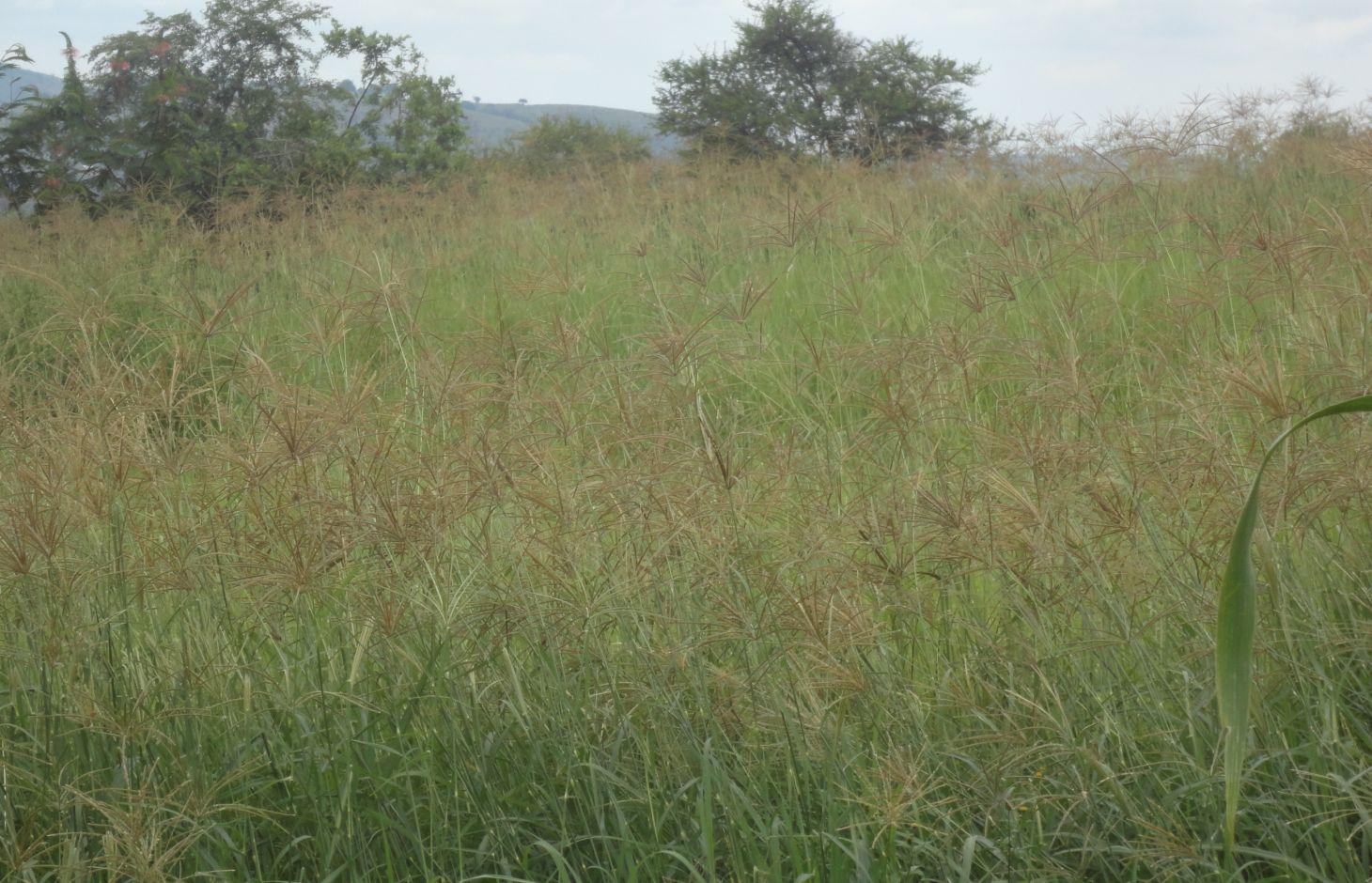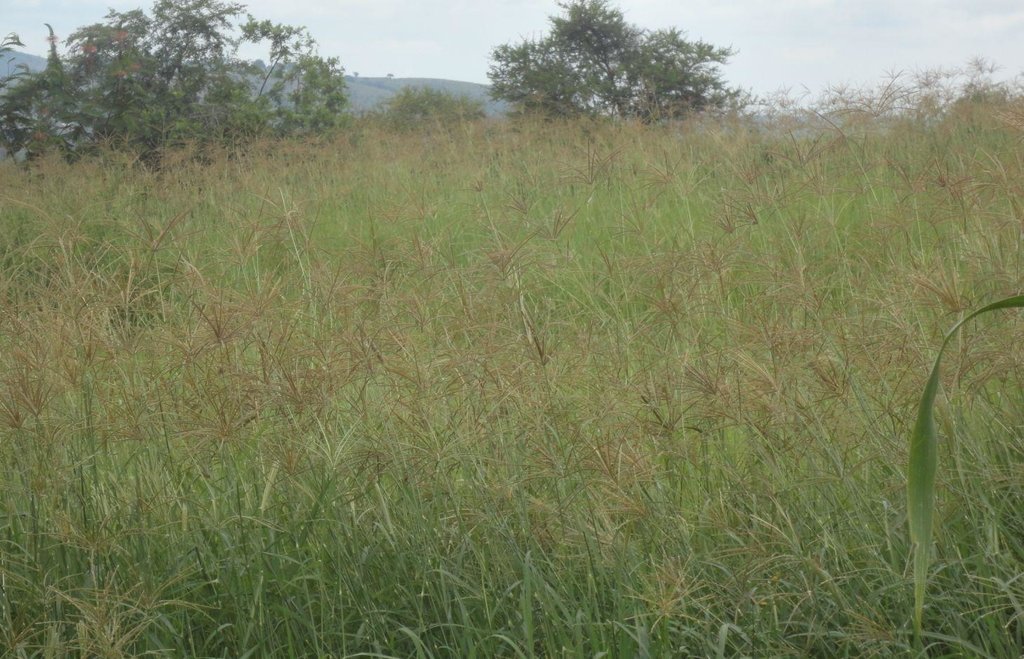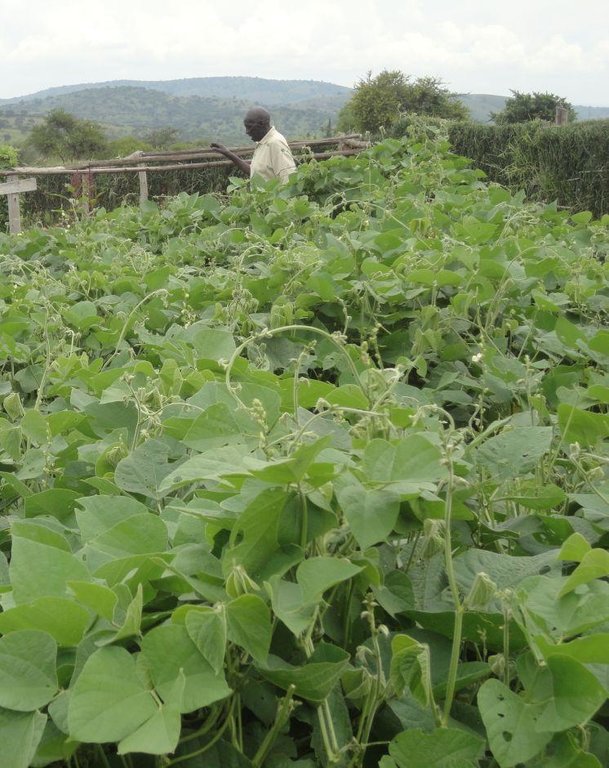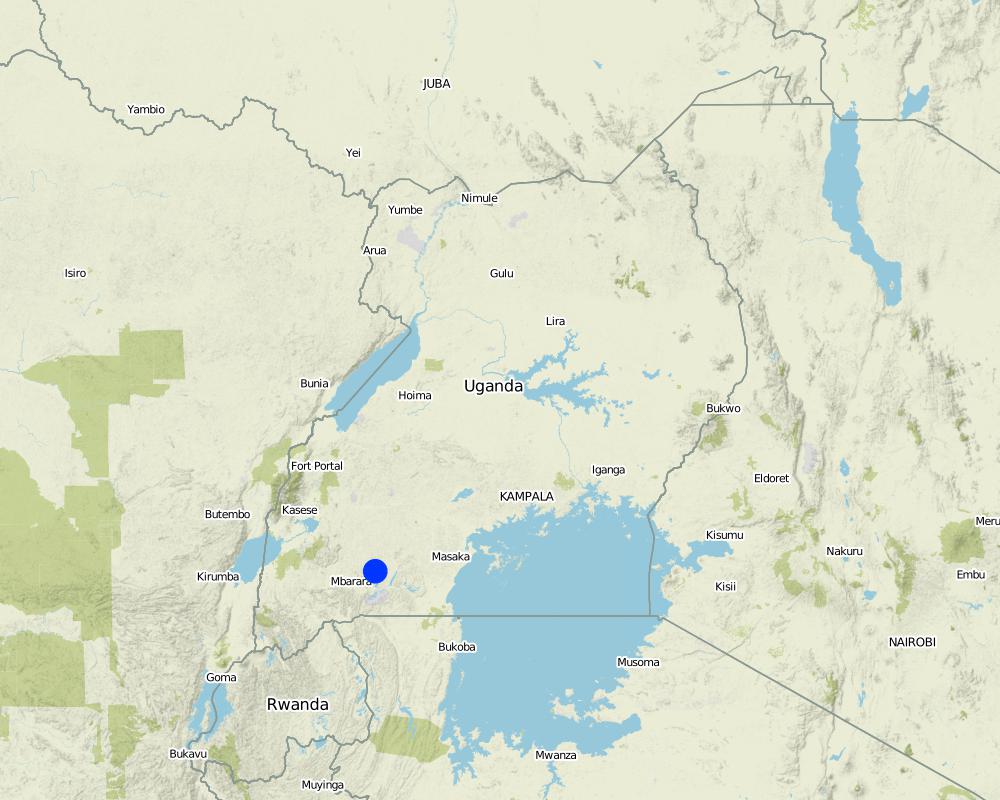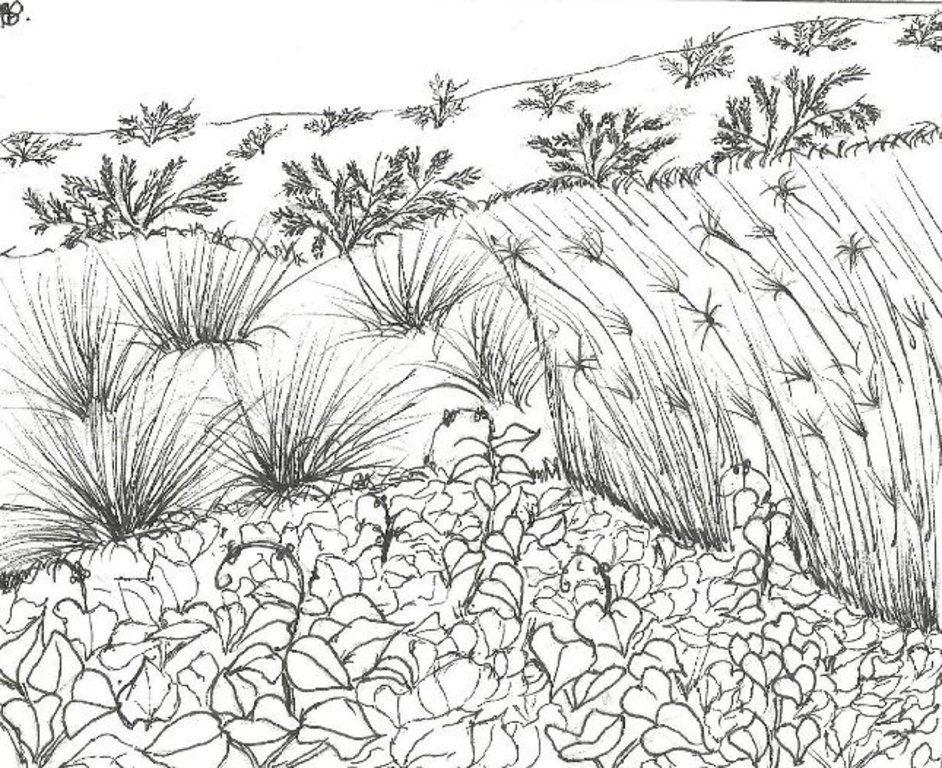Improved fodder production on degraded pastureland [乌干达]
- 创建:
- 更新:
- 编制者: Wilson Bamwerinde
- 编辑者: –
- 审查者: Fabian Ottiger, Alexandra Gavilano
Okubyara Obunyatsi (Runyankore)
technologies_1588 - 乌干达
查看章节
全部展开 全部收起1. 一般信息
1.2 参与该技术评估和文件编制的资源人员和机构的联系方式
SLM专业人员:
SLM专业人员:
有助于对技术进行记录/评估的项目名称(如相关)
The Transboundary Agro-ecosystem Management Project for the Kagera River Basin (GEF-FAO / Kagera TAMP )有助于对技术进行记录/评估的机构名称(如相关)
FAO Food and Agriculture Organization (FAO Food and Agriculture Organization) - 意大利1.3 关于使用通过WOCAT记录的数据的条件
编制者和关键资源人员接受有关使用通过WOCAT记录数据的条件。:
是
2. SLM技术的说明
2.1 技术简介
技术定义:
Transformation of degraded pastureland to high quality fodder plots.
2.2 技术的详细说明
说明:
Grass and legumes are planted on degraded pasture land in fenced fodder plots within the drought prone cattle corridor of Kiruhura district. This climatic zone is characterized by short periods of intense rains followed by long dry spells. Previously, most of the pastoralists of Kiruhura led a nomadic lifestyle, moving their livestock over large areas in search of pasture and water. The combined effects of prolonged droughts and livestock movement over a defined corridor, led to increasing degradation of pastureland, reducing both the quantity and quality of pastures and worsening soil erosion. Therefore the pastoralists have settled down plant pastures instead. Grasses cultivated in the range lands of Kiruhura are Pennisetum purpureum (elephant grass), Stylosanthes guianensis (stylo), Chloris gayana. The legumes are Calliandra spp. and lablab.
Purpose of the Technology: The main objective of the technology is to improve the availability of quality forage and fodder for livestock during the dry season and to feed small ruminants. The other objective is to stop runoff which usually destroys crops, increase water infiltration during the rains and lessen the effect of floods. The benefits of fodder cropping include the protection of soil from erosion by increasing surface cover, improved soil fertility from the legumes, improved livestock production and consequently higher manure production.
Establishment / maintenance activities and inputs: Establishment involves digging, to loosen the soil and remove other grasses that would compete with the planted grasses. Digging is labor intensive and the land owner usually hires labor. The technology requires simple gardening tools such as the hand hoe for digging the soil, and a panga to clear invasive bushes, usually Lantana camara. In addition, irrigation may be necessary in the first 2 to 3 months even during the rainy season. Elephant grass is propagated vegetatively using cuttings planted in rows. Chloris gayana is propagated by broadcasting the seed. Lablab seeds are germinated by soaking in water and then planted directly in the prepared plot. Calliandra is first planted in nurseries before transplanting the seedlings.
Because of the erratic rains, irrigating the plots in the first few months of cultivation is critical.
Natural / human environment: The plots fenced off to protect the fodder crops.
2.3 技术照片
2.5 已应用该技术的、本评估所涵盖的国家/地区/地点
国家:
乌干达
区域/州/省:
Uganda
有关地点的进一步说明:
Kiruhura District (Sanga)
注释:
Boundary points of the Technology area: -0.50810 30.91070; -0.50763 30.91055; -0.50788 30.91006; -0.50838 30.91017; -0.50843 30.91073
Total area covered by the SLM Technology is 0.05 km2.
Acreage under fodder crops is increasing every season as farmers plant more grass and legumes.
Map
×2.6 实施日期
如果不知道确切的年份,请说明大概的日期:
- 不到10年前(最近)
2.7 技术介绍
详细说明该技术是如何引入的:
- 通过项目/外部干预
注释(项目类型等):
Fodder cropping was introduced 2 years ago by Kagera TAMP project
3. SLM技术的分类
3.1 该技术的主要目的
- 改良生产
- 减少、预防、恢复土地退化
3.2 应用该技术的当前土地利用类型
同一土地单元内混合使用的土地::
是
具体说明混合土地使用(作物/放牧/树木):
- 农牧业(包括农牧结合)

农田

牧场
集约放牧/饲料生产:
- 收割和携带/零放牧
- 改良牧场

森林/林地
注释:
Major land use problems (compiler’s opinion): Degradation of pasture range-lands through overgrazing; Animal movement exposes top soil to erosion.
Major land use problems (land users’ perception): Decrease of pasture and water during the dry season; labor to get water and good pasture is a big challenge during prolonged drought.
Cut-and-carry/ zero grazing: Yes
Improved pasture: Yes
Livestock density (if relevant):
25-50 LU /km2
Mixed: (eg agro-pastoralism, silvo-pastoralism): Yes
3.3 由于技术的实施,土地使用是否发生了变化?

农田
- Pennisetum purpureum (elephant grass), Stylosanthes guianensis (stylo), Chloris gayana, Calliandra spp. and lablab

牧场
集约放牧/饲料生产:
- 收割和携带/零放牧
- 改良牧场
注释:
Future (final) land use (after implementation of SLM Technology): Grazing land: Gi: Intensive grazing/ fodder production
Grazing land: Ge: Extensive grazing land
3.4 供水
该技术所应用土地的供水:
- 雨养
3.5 该技术所属的SLM组
- 区域封闭(停止使用,支持恢复)
- 改良的地面/植被覆盖
3.6 包含该技术的可持续土地管理措施

植物措施
- V2:草和多年生草本植物

管理措施
- M2:改变管理/强度级别
注释:
Main measures: vegetative measures, management measures
Type of vegetative measures: in blocks
3.7 该技术强调的主要土地退化类型

土壤水蚀
- Wt:表土流失/地表侵蚀

生物性退化
- Bc:植被覆盖的减少
- Bq:数量/生物量减少
注释:
Main type of degradation addressed: Wt: loss of topsoil / surface erosion, Bc: reduction of vegetation cover
Secondary types of degradation addressed: Bq: quantity / biomass decline
Main causes of degradation: deforestation / removal of natural vegetation (incl. forest fires) (Pasture regeneration practice of bush burning), overgrazing (Maintaining large herds as a repository of wealth), change of seasonal rainfall (Climate change), droughts (Climate change)
Secondary causes of degradation: population pressure (The cattle corridor had a very sparse, mostly nomadic population. Herders have settled down and human population density has grown quite fast in the range-lands)
3.8 防止、减少或恢复土地退化
具体数量名该技术与土地退化有关的目标:
- 减少土地退化
4. 技术规范、实施活动、投入和成本
4.1 该技术的技术图纸
技术规范(与技术图纸相关):
Transformation of degraded pastureland to high quality fodder plots based on establishment of vegetation cover: Pennisetum purpureum (elephant grass), Stylosanthes guianensis (stylo), Chloris gayana, Calliandra and Lablab
Location: Sanga sub-county, Kiruhura district. Uganda
Date: 6-DEC-2013
Technical knowledge required for field staff / advisors: moderate (Methods of land and seed preparation for the various fodder crops)
Technical knowledge required for land users: moderate (Maintenance of the fodder plots)
Main technical functions: control of dispersed runoff: impede / retard, improvement of ground cover, increase in nutrient availability (supply, recycling,…), promotion of vegetation species and varieties (quality, eg palatable fodder)
Secondary technical functions: control of raindrop splash, increase of infiltration, increase / maintain water stored in soil, increase of biomass (quantity)
In blocks
Vegetative material: T : trees / shrubs, G : grass
Trees/ shrubs species: Calliandra Spp. and Grevillea grown in nursery beds before planting; lablab planted directly
Fruit trees / shrubs species: n/a
Perennial crops species: n/a
Grass species: seeds broadcast on land prepared by digging with a hand hoe
Other species: n/a
Slope (which determines the spacing indicated above): 10 - 15%
Change of land use practices / intensity level: From extensive grazing to intensive (semi-zero) grazing
Control / change of species composition: From purely natural pastures to planted fodder crops
作者:
Byonabye Proscovia, Kagera TAMP, Kabale
4.2 有关投入和成本计算的一般信息
其它/国家货币(具体说明):
UGX
如相关,注明美元与当地货币的汇率(例如1美元=79.9巴西雷亚尔):1美元=:
2500.0
注明雇用劳工的每日平均工资成本:
4.00
4.3 技术建立活动
| 活动 | 时间(季度) | |
|---|---|---|
| 1. | Preparation of fodder plots (bush clearing, digging, fencing) | dry season |
| 2. | Nursery establishment for Calliandra | dry season |
| 3. | Planting | Beginning of wet season |
| 4. | Weeding | Wet season |
| 5. | Paddocking | dry season |
4.4 技术建立所需要的费用和投入
| 对投入进行具体说明 | 单位 | 数量 | 单位成本 | 每项投入的总成本 | 土地使用者承担的成本% | |
|---|---|---|---|---|---|---|
| 劳动力 | Labour | ha | 1.0 | 110.0 | 110.0 | 100.0 |
| 设备 | Tools | ha | 1.0 | 8.0 | 8.0 | 100.0 |
| 植物材料 | Seeds | ha | 1.0 | 25.0 | 25.0 | |
| 肥料和杀菌剂 | Compost/manure | ha | 1.0 | 30.0 | 30.0 | 100.0 |
| 施工材料 | Wood | ha | 1.0 | 200.0 | 200.0 | 50.0 |
| 施工材料 | Fencing wire (roll) | ha | 1.0 | 40.0 | 40.0 | 100.0 |
| 技术建立所需总成本 | 413.0 | |||||
| 技术建立总成本,美元 | 0.17 | |||||
注释:
Duration of establishment phase: 18 month(s)
4.5 维护/经常性活动
| 活动 | 时间/频率 | |
|---|---|---|
| 1. | Weeding and fodder preparation | wet season |
| 2. | Gap-filling/replanting | Wet season |
| 3. | Maintenance of paddocks | 2 times a year |
4.6 维护/经常性活动所需要的费用和投入(每年)
| 对投入进行具体说明 | 单位 | 数量 | 单位成本 | 每项投入的总成本 | 土地使用者承担的成本% | |
|---|---|---|---|---|---|---|
| 劳动力 | Labour | ha | 1.0 | 60.0 | 60.0 | 100.0 |
| 设备 | Tools | ha | 1.0 | 8.0 | 8.0 | 100.0 |
| 植物材料 | Seeds | ha | 1.0 | 25.0 | 25.0 | 100.0 |
| 肥料和杀菌剂 | Compost/manure | ha | 1.0 | 30.0 | 30.0 | 100.0 |
| 施工材料 | Wood | ha | 1.0 | 100.0 | 100.0 | 100.0 |
| 施工材料 | Fencin wire | ha | 1.0 | 40.0 | 40.0 | 100.0 |
| 技术维护所需总成本 | 263.0 | |||||
| 技术维护总成本,美元 | 0.11 | |||||
注释:
Machinery/ tools: hand hoe, panga, rake, n/a
The calculations above were done in December 2013, for gently sloping land (< 6%), for each of 5 hectares covered by the technology.
4.7 影响成本的最重要因素
描述影响成本的最决定性因素:
Fencing the land is the most important factor in establishing the technology. The whole cattle corridor is an extended range land with a lot of livestock. Fodder plots constantly face destruction by freely roaming livestock and therefore fencing is a requirement. Paddocking also requires fencing to divide the farm into portions of pasture. Both materials and labor are costly.
5. 自然和人文环境
5.1 气候
年降雨量
- < 250毫米
- 251-500毫米
- 501-750毫米
- 751-1,000毫米
- 1,001-1,500毫米
- 1,501-2,000毫米
- 2,001-3,000毫米
- 3,001-4,000毫米
- > 4,000毫米
有关降雨的规范/注释:
850 mm to 900 mm
农业气候带
- 半湿润
Thermal climate class: Tropics. At the Equator with 180 days of growing period
5.2 地形
平均坡度:
- 水平(0-2%)
- 缓降(3-5%)
- 平缓(6-10%)
- 滚坡(11-15%)
- 崎岖(16-30%)
- 陡峭(31-60%)
- 非常陡峭(>60%)
地形:
- 高原/平原
- 山脊
- 山坡
- 山地斜坡
- 麓坡
- 谷底
垂直分布带:
- 0-100 m a.s.l.
- 101-500 m a.s.l.
- 501-1,000 m a.s.l.
- 1,001-1,500 m a.s.l.
- 1,501-2,000 m a.s.l.
- 2,001-2,500 m a.s.l.
- 2,501-3,000 m a.s.l.
- 3,001-4,000 m a.s.l.
- > 4,000 m a.s.l.
关于地形的注释和进一步规范:
Altitudinal zone: 1001-1500 m a.s.l. (1330 m to 1345 m a.s.l.)
Slopes on average: Gentle (Extensive area of grazing land cover both gentle and moderate slopes) and moderate (both ranked 2)
5.3 土壤
平均土层深度:
- 非常浅(0-20厘米)
- 浅(21-50厘米)
- 中等深度(51-80厘米)
- 深(81-120厘米)
- 非常深(> 120厘米)
土壤质地(表土):
- 中粒(壤土、粉土)
表土有机质:
- 低(<1%)
如有可能,附上完整的土壤描述或具体说明可用的信息,例如土壤类型、土壤酸碱度、阳离子交换能力、氮、盐度等。:
Soil fertility: Medium
Soil drainage/infiltration: Medium
Soil water storage capacity: Medium
5.4 水资源可用性和质量
地下水位表:
5-50米
地表水的可用性:
中等
水质(未处理):
不良饮用水(需要处理)
5.5 生物多样性
物种多样性:
- 低
5.6 应用该技术的土地使用者的特征
生产系统的市场定位:
- 生计(自给)
非农收入:
- 低于全部收入的10%
相对财富水平:
- 平均水平
- 丰富
个人或集体:
- 个人/家庭
性别:
- 男人
说明土地使用者的其他有关特征:
Land users applying the Technology are mainly common / average land users
Difference in the involvement of women and men: Herds and the land they graze on traditionally belongs to men. This seems to have remained the case, where women's roles are within the house and around the compound while men tend the live stock. Nonetheless, women are getting hired as labourers in the nurseries and for digging.
Population density: 10-50 persons/km2
Annual population growth: 2% - 3%
15% of the land users are rich and own 30% of the land (can afford to spend 150.00 US$ per month on farm expenses).
60% of the land users are average wealthy and own 40% of the land (can spend 500.00 annually on the farm).
Off-farm income specification: Most of the economy in Kiruhura district is farm-based. Almost everybody earns directly from their farm produce or labour.
Market orientation: Mixed (ranked 1, herders have surplus milk for sale) and subsistence (ranked 2, herders grow their own food)
5.7 应用该技术的土地使用者使用的平均土地面积
- < 0.5 公顷
- 0.5-1 公顷
- 1-2 公顷
- 2-5公顷
- 5-15公顷
- 15-50公顷
- 50-100公顷
- 100-500公顷
- 500-1,000公顷
- 1,000-10,000公顷
- > 10,000公顷
这被认为是小规模、中规模还是大规模的(参照当地实际情况)?:
- 中等规模的
5.8 土地所有权、土地使用权和水使用权
土地所有权:
- 个人,未命名
土地使用权:
- 个人
用水权:
- 自由进入(无组织)
注释:
Once herders started settling down land came under individual ownership. This development is only a few decades old. Water is still under open access.
5.9 进入服务和基础设施的通道
健康:
- 贫瘠
- 适度的
- 好
教育:
- 贫瘠
- 适度的
- 好
技术援助:
- 贫瘠
- 适度的
- 好
就业(例如非农):
- 贫瘠
- 适度的
- 好
市场:
- 贫瘠
- 适度的
- 好
能源:
- 贫瘠
- 适度的
- 好
道路和交通:
- 贫瘠
- 适度的
- 好
饮用水和卫生设施:
- 贫瘠
- 适度的
- 好
金融服务:
- 贫瘠
- 适度的
- 好
6. 影响和结论性说明
6.1 该技术的现场影响
社会经济效应
生产
饲料生产
SLM之前的数量:
0 acre
SLM之后的数量:
6 acre
饲料质量
畜牧生产
生产故障风险
收入和成本
农业投入费用
农业收入
工作量
社会文化影响
社区机构
SLM/土地退化知识
冲突缓解
Improved livelihoods and human well-being
注释/具体说明:
Implementation of the fodder cropping technology helps to maintain small and productive herds in a short distance from the households. As a result, milk production improved significantly, thereby improving household incomes.
生态影响
水循环/径流
地表径流
蒸发
土壤
土壤覆盖层
土壤流失
土壤结壳/密封
土壤压实
养分循环/补给
生物多样性:植被、动物
生物量/地上C
减少气候和灾害风险
火灾风险
6.2 该技术的场外影响已经显现
对邻近农田的破坏
对公共/私人基础设施的破坏
6.3 技术对渐变气候以及与气候相关的极端情况/灾害的暴露和敏感性(土地使用者认为的极端情况/灾害)
渐变气候
渐变气候
| 季节 | 增加或减少 | 该技术是如何应对的? | |
|---|---|---|---|
| 年温度 | 增加 | 未知 |
气候有关的极端情况(灾害)
气象灾害
| 该技术是如何应对的? | |
|---|---|
| 局地暴雨 | 好 |
| 局地风暴 | 好 |
气候灾害
| 该技术是如何应对的? | |
|---|---|
| 干旱 | 好 |
水文灾害
| 该技术是如何应对的? | |
|---|---|
| 比较和缓的(河道)洪水 | 未知 |
其他气候相关的后果
其他气候相关的后果
| 该技术是如何应对的? | |
|---|---|
| 缩短生长期 | 好 |
注释:
In preparation for extended drought, hay is made during the rainy season when there is abundant grass.
6.4 成本效益分析
技术收益与技术建立成本相比如何(从土地使用者的角度看)?
短期回报:
轻度消极
长期回报:
非常积极
技术收益与技术维护成本/经常性成本相比如何(从土地使用者的角度看)?
短期回报:
积极
长期回报:
非常积极
注释:
Establishment costs are rather high. In the medium to longer term, the benefits are immense. Maintenance costs are reduced once the technology is established because expenditure on animal drugs goes down with decreasing parasite infestations (especially ticks) which were a result of mixing with untreated herds before.
6.5 技术采用
如若可行,进行量化(住户数量和/或覆盖面积):
20
在所有采用这项技术的人当中,有多少人是自发的,即未获得任何物质奖励/付款?:
- 11-50%
注释:
75% of land user families have adopted the Technology with external material support
15 land user families have adopted the Technology with external material support
Comments on acceptance with external material support: Supply of grass and legume seeds was done for the original 15 families; 5 more families are working on the technology after seeing its results from their neighbours.
25% of land user families have adopted the Technology without any external material support
5 land user families have adopted the Technology without any external material support
Comments on spontaneous adoption: 5 farmers have adopted the technology without getting any external help
There is a moderate trend towards spontaneous adoption of the Technology
Comments on adoption trend: 25% of the farmers who adopted the technology did so without external support.
6.7 该技术的优点/长处/机会
| 土地使用者眼中的长处/优势/机会 |
|---|
|
Improved income from milk with reduced expenses on acaricides and other drugs means that household income is higher How can they be sustained / enhanced? Encourage improvement of the herd by reducing the numbers and enhancing the quality through breeding and acqusition |
|
Less time is spent on searching for pastures further afield. How can they be sustained / enhanced? Encourage the herder to put more acreage under planted pastures |
| 编制者或其他关键资源人员认为的长处/优势/机会 |
|---|
|
There is enough grass and fodder for the herd during the rainy season and hay during the extended droughts. How can they be sustained / enhanced? More mobilization campaigns, grass and legume seeds and other incentives should be availed to the herders to enhance rate and extent of adoption. |
|
Intensive grazing favours smaller, high productivity herds How can they be sustained / enhanced? Policy to improve herd quality should be pursued at government level |
|
Planted pasture enhances responsibility to protect and maintain grazing land by the owner, thereby improving capacity to sustain soil management benefits (increased surface cover, reduced water erosion) How can they be sustained / enhanced? Community level by-laws should be enacted to compel every herder to have some planted pastures for fodder. |
|
Improved milk and other farm product yields How can they be sustained / enhanced? Introduce marketing strategies including cooperatives to ensure that the benefits go to the farmers and not marketing middle-men. |
6.8 技术的弱点/缺点/风险及其克服方法
| 土地使用者认为的弱点/缺点/风险 | 如何克服它们? |
|---|---|
| There is shortage of labor to increase acreage, cut the grass and legumes from the pasture plots and prepare fodder for semi zero-grazing | Use simple machines where possible |
| 编制者或其他关键资源人员认为的弱点/缺点/风险 | 如何克服它们? |
|---|---|
| Establishment costs are rather high | Benefits demonstrated by the herders who adopted the technology should convince government and commercial banks that the technology is profitable. Upon this evidence alone, these institutions should avail the herders the necessary capital. |
| Technology is labour intensive | Productivity is even higher, therefore innovations that introduce mechanization should be encouraged (it is the normal progression of agricultural/industrial development) |
7. 参考和链接
7.1 信息的方法/来源
7.2 参考可用出版物
标题、作者、年份、ISBN:
Kagera TAMP project website
可以从哪里获得?成本如何?
http://www.fao.org/nr/kagera/en/
链接和模块
全部展开 全部收起链接
无链接
模块
无模块


